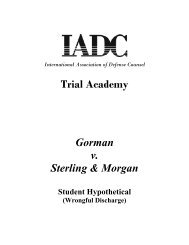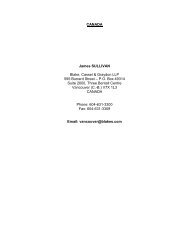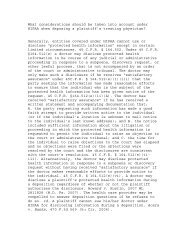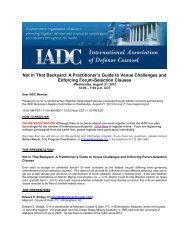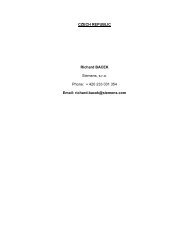Defense Counsel Journal - International Association of Defense ...
Defense Counsel Journal - International Association of Defense ...
Defense Counsel Journal - International Association of Defense ...
Create successful ePaper yourself
Turn your PDF publications into a flip-book with our unique Google optimized e-Paper software.
Page 474 DEFENSE COUNSEL JOURNAL–October 2012LaMarche as binding precedentin this case. 21The problem with this transparentjustification is that it fails to explain howconsidering the language <strong>of</strong> an exclusioncan aid in the determination <strong>of</strong> theinsuring agreement. In LaMarche, thecoverage grant was identical to that atissue in J.S.U.B., requiring an“occurrence” resulting in “propertydamage.” The exclusion at issue inLaMarche was the former exclusion (o),which equates to the current exclusion (l),or the damage to “your work” exclusion.The former provision stated that theinsurance did not apply:to property damage to workperformed by or on behalf <strong>of</strong> thenamed insured arising out <strong>of</strong> thework or any portion there<strong>of</strong>, orout <strong>of</strong> materials, parts orequipment furnished inconnection therewith. 22By contrast, the current exclusion (l),excludes coverage for:“Property damage” to “yourwork” arising out <strong>of</strong> it or any part<strong>of</strong> it and included in the“products-completed operationshazard”.This exclusion does not apply if thedamaged work or the work out <strong>of</strong> whichthe damage arises was performed on yourbehalf by a subcontractor.21 J.S.U.B., 979 So. 2d at 882.22 LaMarche, 390 So. 2d at 326.So, the newer provision removeswork performed on the insured’s behalffrom the exclusion, whereas the olderversion expressly included workperformed on the insured’s behalf.Having recited the foregoingdifferences, the Court then resumed itsanalysis <strong>of</strong> whether defective constructionconstituted an “occurrence.” After citingto several other state decisions whichfound that such defects were“occurrences,” it then completely omittedany analysis <strong>of</strong> the issue and simply putforth the bold proposition that:If U.S. Fire intended to precludecoverage based on the cause <strong>of</strong>action asserted, it was incumbenton U.S. Fire to include clearlanguage to accomplish thisresult. ... In fact, there is abreach <strong>of</strong> contract endorsementexclusion, not present in the CGLpolicies at issue in this case, thatexcludes coverage for breach <strong>of</strong>contract claims. ... 23Of course, the court did not explainwhy U.S. Fire needed to include anendorsement to exclude coverage whichthe Florida Supreme Court had alreadyannounced did not exist. Analyzingwhether the insuring agreement <strong>of</strong> thepolicy is triggered in the first instance iscertainly different from analyzingwhether the exclusions bar coveragewhich otherwise exists. In other words,the Court put the proverbial cart beforethe horse by concluding that U.S. Firefailed to use clear language to precludecoverage.23 J.S.U.B., 979 So. 2d at 884.



